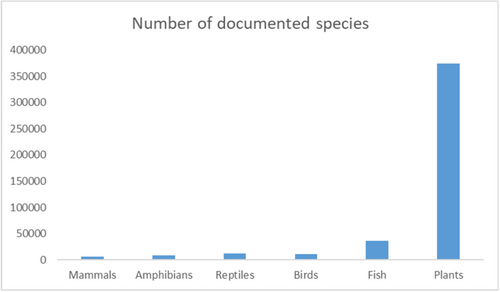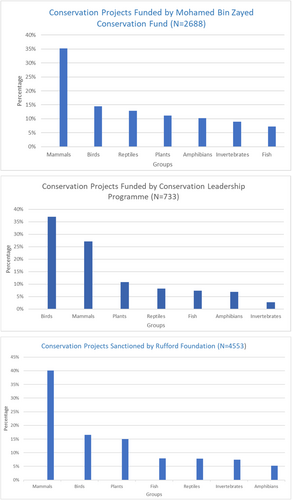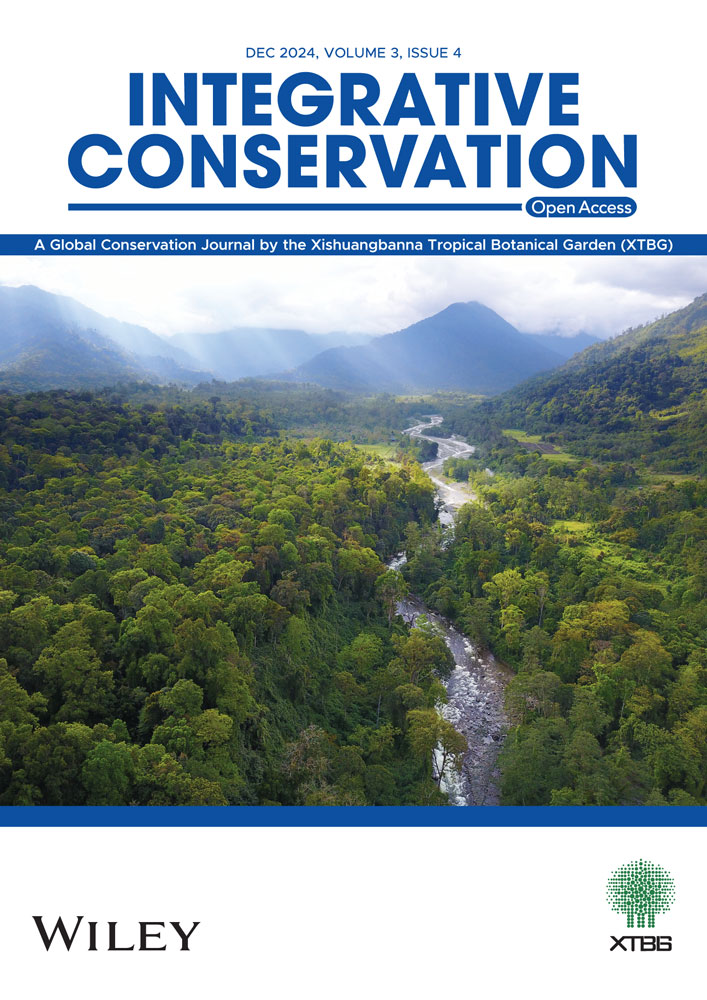Persisting plant blindness in conservation efforts
在保护工作中一直被忽视的植物保护
Editor-in-Chief & Handling Editor: Ahimsa Campos-Arceiz
Abstract
enPlants receive significantly less attention in conservation efforts than other groups. Conservation and funding are often directed towards more charismatic animal groups. Considering that two out of every five plant species face the risk of extinction, the limited expenditure on plant conservation is particularly concerning. An unbiased distribution of funding across conservation priorities is urgently needed.
摘要
zh植物在保护工作中受到的关注远远少于其他物种。保护和资金通常集中于那些更具魅力的动物群体。考虑到每五种植物中就有两种面临灭绝风险,植物保护方面的资金投入不足更令人担忧。在保护优先事项之间公平分配资金的需求已十分迫切。【审阅:杨斌】
Plants are fascinating and fundamental organisms that comprise about 80% of all biomass on Earth (Bar-On et al., 2018). Life on Earth depends on plants, making the conservation of plant biodiversity essential for securing the future of our planet. Extinctions pose the greatest threat to plant biodiversity, with plant species disappearing at a rate 500 times faster than the natural baseline (Humphreys et al., 2019). These botanical extinctions are often poorly documented and, in many cases, completely silent (Christenhusz & Govaerts, 2024). Plant extinctions also endanger other organisms, ecosystems, and human well-being, as most life forms depend directly or indirectly on plants for survival.
The International Union for Conservation of Nature Red List of Threatened Species (IUCN Red List) records 114 plant species as extinct; however, the actual number of plant extinctions is estimated to be four times higher (Humphreys et al., 2019). While 71% of known vertebrate species have been assessed by the IUCN, only about 17% of known plant species have been evaluated (IUCN, 2024), indicating that efforts to assess plant extinctions are far less advanced than those for vertebrates. Cycads, cacti, and conifers are three of the top five most vulnerable taxonomic groups, according to the IUCN Red List (Goettsch et al., 2015). However, as previously mentioned, in terms of assessment and conservation, plants receive considerably less attention. Over the past 250 years, 571 plant species have gone extinct—more than twice the combined total of extinct birds, mammals, and amphibians (217 species) (Briggs, 2019). This points to an urgent need to prioritise plants within conservation efforts.
Despite their importance, plants are frequently overlooked or undervalued by the wider public, as well as by many researchers. Many people fail to recognise or appreciate the value of plants and are often unaware of the myriad of roles they play in our lives (Jose et al., 2019). “Plant blindness” (also known as “zoocentrism” or “zoochauvinism”), a phenomenon initially defined by Wandersee and Schussler as ‘the misguided anthropocentric ranking of plants as inferior to animals”, describes this widespread disregard. Recently, the term “plant blindness” has been updated to “plant awareness disparity” (Parsley, 2020).
There are many examples of plant blindness, or lack of plant awareness, in our daily lives, but here, we focus on plant blindness within the field of conservation. A recent legislative content analysis conducted across 185 countries found that only 69 pieces of legislation explicitly included plants in their definition of “wildlife”, while 10 definitions specifically excluded them (Wyatt, 2021). This indicates that, even in legislation, plants are often overlooked in conservation measures.
Illegal trade is another significant issue in conservation. Compared with animals, the illegal trade in plants is more lucrative. The Convention on International Trade in Endangered Species of Wild Fauna and Flora (CITES) recognises 30,000 plant species as threatened by illegal trade, compared to only 5000 animals. Despite this, plants are underrepresented in Illegal Wildlife Trade initiatives (Margulies et al., 2019). For example, the Orchidaceae family alone makes up more than 70% of all species included in the CITES appendices (Hinsley et al., 2017), yet recent conservation efforts are heavily focused on the global trade of charismatic endangered animals, such as pangolins, tigers, elephants, and rhinoceroses.
There is a notable “taxonomic bias” in conservation efforts and related funding (Clark & May, 2002). Even the United States Endangered Species Act (ESA) has been criticised for prioritising charismatic animals over plants (Male & Bean, 2005). Social preferences influence such scientific biases, reflected in the value that society assigns to various taxa (Martín-López et al., 2008). Perhaps due in part to their lack of broad public appeal, plant conservation receives far less attention and funding than animal conservation (Goettsch et al., 2015). From 1992 to 2020, conservation funding for animal species was three times greater than for plants (Adamo et al., 2022). Plants account for the largest number of listed species but receive the lowest funding per species (Figure 1). The majority of conservation funds are allocated to amphibians, birds, fishes, mammals, and reptiles, despite these groups comprising only 23% of described species (Adamo et al., 2022). Both funding agencies and the public are more inclined to support the conservation of species that they find attractive (Knight, 2008). An examination of conservation projects sanctioned by major funding agencies shows that plants are comparatively overlooked (Figure 2).


Furthermore, conservation funding does not appear to correlate with extinction risk. Funding for plant conservation is often awarded without regard to a species' risk of extinction. In biodiversity-rich regions of the southern hemisphere, funding for plant protection is significantly lower than in northern regions with less diversity. More resources are allocated to plants at high latitudes, particularly those with larger ranges and attractive flowers (Adamo et al., 2022). Endangered yet less visually appealing plant species, as well as endemic species, are rarely prioritised and sometimes ignored entirely. Generally, only regional or national institutions show interest in conserving endemic species. International journals also tend to avoid publishing single-species, single-country studies, even for threatened endemics, typically redirecting such research to regional journals. Fieldwork in plant conservation also faces challenges due to limited funding and the difficulty of obtaining necessary permits, impacting species documentation and other research (Christenhusz & Govaerts, 2024). With reduced fieldwork, many plant extinctions are likely to go unnoticed in the future. The fundamental cause of these barriers lies in a lack of plant awareness among governments, funding agencies, research institutions, and the wider public.
In this Anthropocene era, human activities have had a profound impact on ecosystems and biodiversity (Christenhusz & Govaerts, 2024). Our actions and decisions continue to shape the future of this planet and its organisms, placing a duty on us to conserve the existing biodiversity for the well-being of all life. Considering that two out of every five plant species face the threat of extinction, the limited funding directed toward plant conservation is particularly concerning (Antonelli et al., 2020). Many plant species remain undocumented, underscoring the need for greater attention and funding in plant conservation. Improved public understanding of the vital role plants play in sustaining life on Earth, along with a growing enthusiasm to protect them, could positively influence the resources allocated to their conservation (Balding & Williams, 2016). An unbiased distribution of funds is needed in the field of conservation.
AUTHOR CONTRIBUTIONS
Jithu K Jose: Conceptualisation; data curation; formal analysis; funding acquisition; investigation; methodology; resources; software.
ACKNOWLEDGEMENTS
No funding received for this study.
CONFLICT OF INTEREST STATEMENT
The author declares no conflicts of interest.
Open Research
DATA AVAILABILITY STATEMENT
Not applicable.




